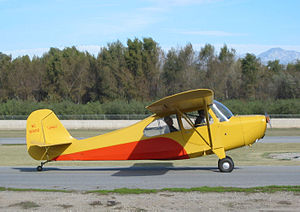Aeronca Champion
| Model 7 Champion | |
|---|---|
 |
|
| Role | Light utility aircraft / Trainer |
| Designer | Ray Hermes |
| First flight | April 29, 1944 |
| Introduction | November 1945 |
| Status | In production |
| Primary users | private owners flight schools, aircraft rental services, United States Air Force, Air National Guard U.S. Army Civil Air Patrol |
| Produced | 1946-1951 2007-present |
| Number built | more than 10,000, all manufacturers and variants (over 7,200 Aeronca 7AC Champion, 1945-1948) |
| Unit cost |
US$2,395 (1946)
US$88,900 (2015) |
| Developed from | Aeronca L-3, Aeronca T, Aeronca Defender, Aeronca 50 Chief |
| Variants | Aeronca L-16 |
| Developed into | Citabria, Champion Lancer |
The Aeronca Model 7 Champion, commonly known as the "Champ", or "Airknocker", is a single-engine, two-seat, light airplane, with a high wing and fixed conventional landing gear. Designed for flight training and personal use—and specifically developed to compete with the popular Piper Cub, entered production in the United States in 1945, spawning one of the most popular, and longest-produced, light airplane models in the world.
In addition to the Champ's large-volume production by Aeronca, it was revived in variations by the Champion Aircraft Company in the 1950s and 1960s, and then again in further variants by Bellanca in the 1960s and 1970s, and by American Champion Aircraft in the early 2000s.
To take advantage of the new light-sport aircraft (LSA) category, the Champion was returned to production in 2007.
The Aeronca 7 Champion line—developed in the mid-1940s as a post-World War II response to the popular Piper J-3 Cub—uses similar design features (already featured in Aeronca's wartime designs, the Aeronca Model T, Aeronca Defender, and Aeronca L-3), but also incorporates aspects of traditional Aeronca designs, including the internal main trusswork of the fuselage frame. Like its predecessors and initial rivals, the high-wing, two-seat plane has tandem seating, conventional landing gear (tailwheel-equipped), and a small piston engine.
As with many light aircraft of the time, the Champ’s fuselage and tail surfaces are constructed of welded metal tubing. The outer shape of the fuselage is created by a combination of wooden formers and longerons, covered with fabric. The cross-section of the metal fuselage truss is triangular, a design feature which can be traced all the way back to the earliest Aeronca C-2 design of the late 1920s.
...
Wikipedia
